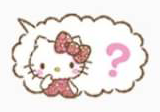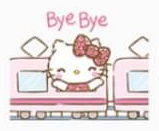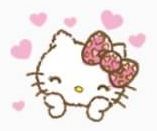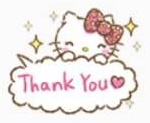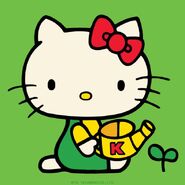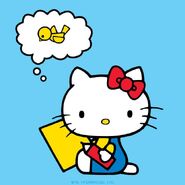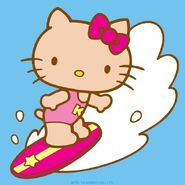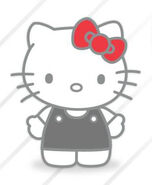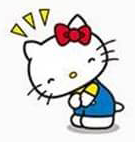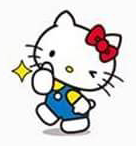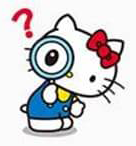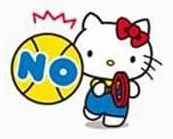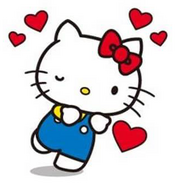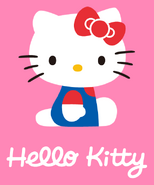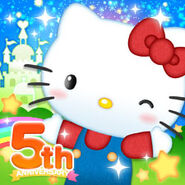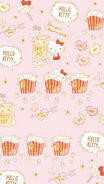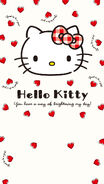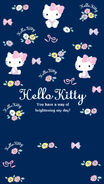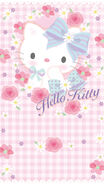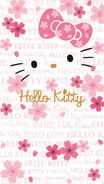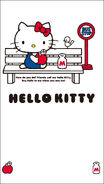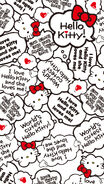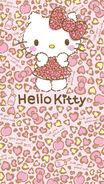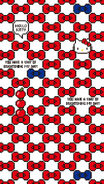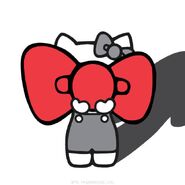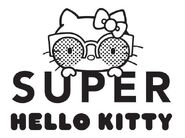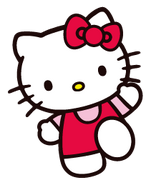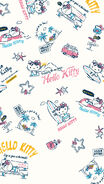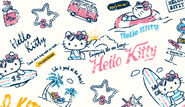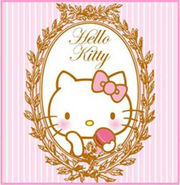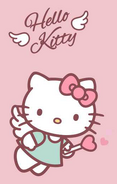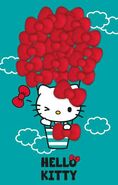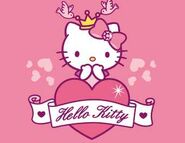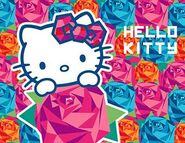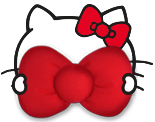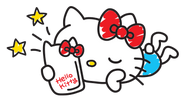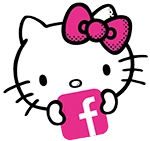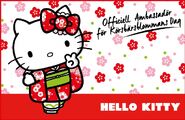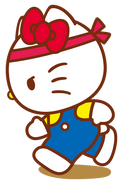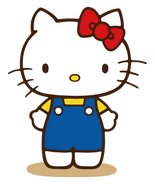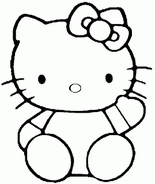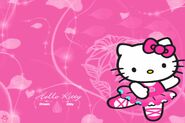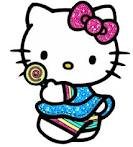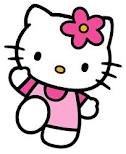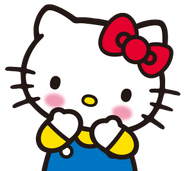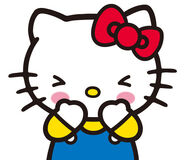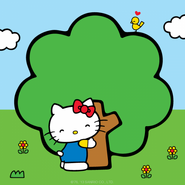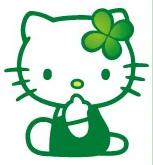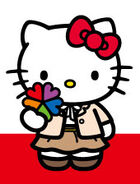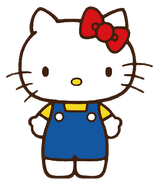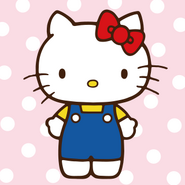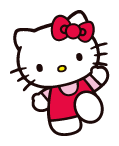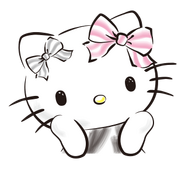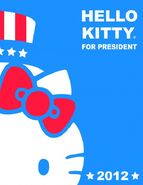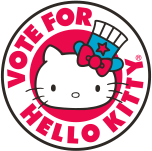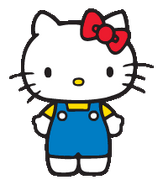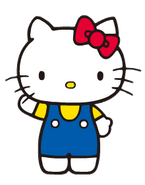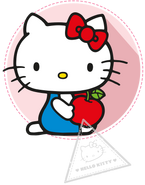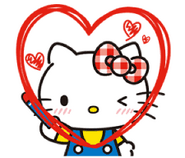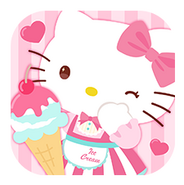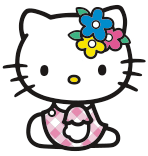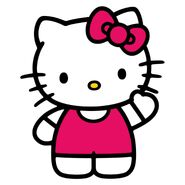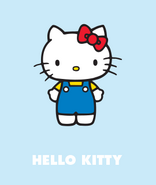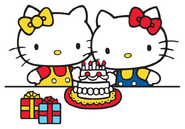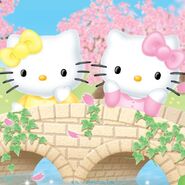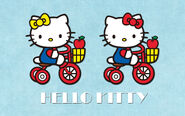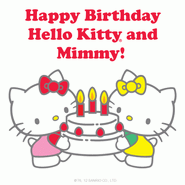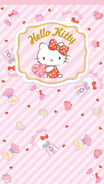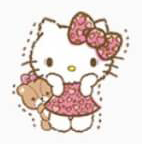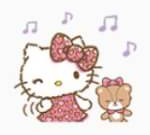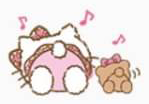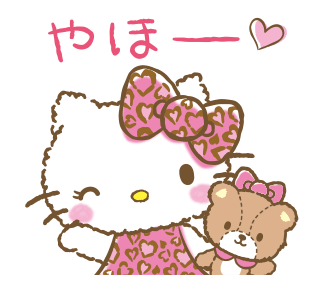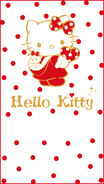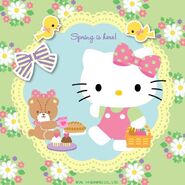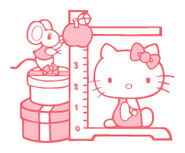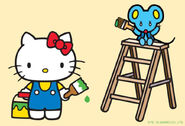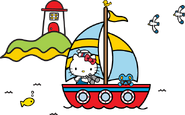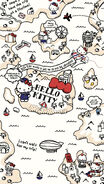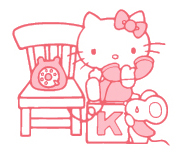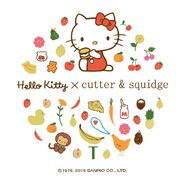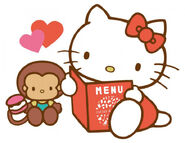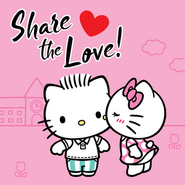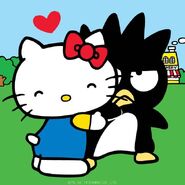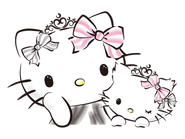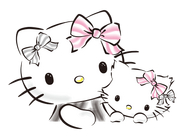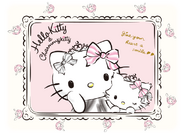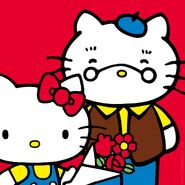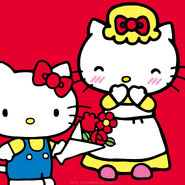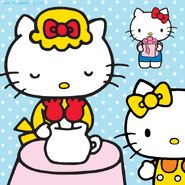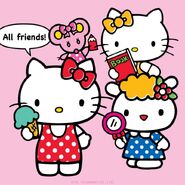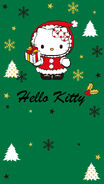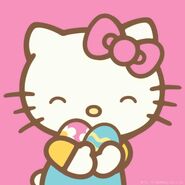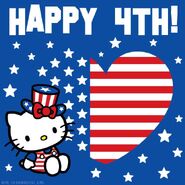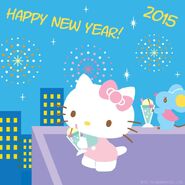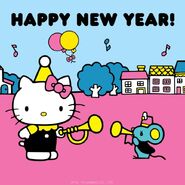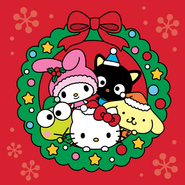Hello Kitty (ハローキティ, Harō Kitī), also known by her full name as Kitty White (キティ・ホワイト, Kitī Howaito), is a fictional character produced by the Japanese company Sanrio, created by Yuko Shimizu, and designed by Yuko Yamaguchi. She is portrayed as a female white Japanese Bobtail Cat with a red bow worn on her left ear. The character's first appearance on an item, a vinyl coin purse, was introduced in Japan in 1974 and brought to the United States in 1976.
The character is a staple of the kawaii segment of Japanese pop culture. The Hello Kitty trademark has spread globally; Sanrio earned over $1 billion annually in sales outside of Japan, as of 2003. Although mainly aimed at the pre-adolescent female market, the Hello Kitty product range goes all the way from purses, stickers and pen sets to toasters, televisions, clothing, massagers, and computer equipment. It has a cult-like following among adults as well, especially in Asia, where Hello Kitty adorns cars, purses, jewelry and many other high-end consumer products. Several Hello Kitty TV series, targeted towards young children, has also been produced. Examples of products depicting the character include dolls, stickers, greeting cards, clothes, accessories, school supplies, dishes and home appliances. Her fame has led her to the creation of two officially licensed theme parks, Harmonyland and the indoor Sanrio Puroland.
Character Information
Per official character profiles for Hello Kitty, her real name is Kitty White and she was born in the suburbs of London, England on November 1. Her height is described as five apples and her weight as three apples. She is portrayed as a cute, bright, sweet, kind-hearted and tomboyishly beautiful girl, who's very close to her twin sister Mimmy. She is good at baking cookies and loves Mama's homemade apple pie. She likes to collect cute things and her favorite subjects in school are English, music and art. Her blood type is A.
History
In 1962, Shintaro Tsuji, founder of Sanrio, began selling rubber sandals with flowers painted on them. Tsuji noted the profits gained by adding a cute design to the sandals and hired cartoonists to design cute characters for his merchandise. The company produced a line of character merchandise around gift-giving occasions. Hello Kitty was designed by Yuko Shimizu and was added to the lineup of early Sanrio characters in 1974. The character's first appearance on an item was a vinyl coin purse in Japan. She first appeared in the United States in 1976.
A spokesperson for Sanrio says that Hello Kitty is not normally given a mouth because "without the mouth, it is easier for the person looking at Hello Kitty to project their feelings onto the character" and that "the person can be happy or sad together with Hello Kitty." There has been some suggestion that Hello Kitty has its origins in Maneki Neko, and that the name Hello Kitty itself is a back-translation of Maneki Neko, which means "beckoning cat" in English.
Animal Crossing: New Leaf
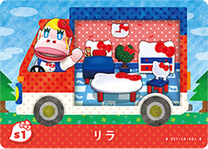
Rilla, the Hello Kitty-based character, driving her RV filled with exclusive Hello Kitty furniture.
Hello Kitty and some of her Sanrio friends were added into Animal Crossing: New Leaf on November 2, 2016 as part of the Welcome Amiibo update. Hello Kitty became a gorilla character named Rilla. Rilla has an RV and home filled with furniture related to Hello Kitty. The character and furniture can only be obtained by scanning Rilla's amiibo card and allowing her to visit your campground. The cards must be specially ordered from Europe or Japan as they are not sold anywhere else, and can only be purchased online. The cards are now out of print, therefore they must be ordered from a third-party dealer. Despite all this, Rilla is a gorilla and not a cat like Hello Kitty.
Popularity
In May 2008, Japan named Hello Kitty the ambassador of Japanese tourism in both China and Hong Kong, which are two places where the character is exceptionally popular among children and young women. This marked the first time Japan's tourism ministry had appointed a fictional character to the role.
UNICEF has also awarded Hello Kitty the exclusive title of UNICEF Special Friend of Children.
Hello Kitty's popularity began waning in Japan before the year 2000. In 2002, Hello Kitty lost her place as the top-grossing character in Japan in the Character Databank popularity chart and has never recovered. In a 2010 survey, she was in third place behind Anpanman and Pikachu from Pokémon.
As of August 2007, Thai police officers who have committed minor transgressions such as showing up late or parking in the wrong place are forced to wear pink Hello Kitty armbands for several days as penance.
During the financial crisis of 2007–2010, a poster of a Hello Kitty pre-paid debit card expanded to roughly 1 meter in length was displayed on the floor of the US Senate by Senator Byron Dorgan as a demonstration of extreme methods used by credit companies to attract "children 10 to 14 years of age". Though not an actual credit card, it was criticized for its promotional website encouraging users to "shop 'til you drop."
For the 50th anniversary of Sanrio, Sanrio and Girl Skateboards collaborated and released skateboards with a Hello Kitty graphic. There is a Hello Kitty store in Africa opening 2013.
As of 8/28/14 it was rumored Hello Kitty is a human girl and not a cat. However, it has been confirmed that Hello Kitty is actually a gijinka (anthropomorphic) cat and not human.[1]
There is a themed restaurant named Hello Kitty Sweets in Taipei, Taiwan. The restaurant's decor and many of its dishes are patterned after the Hello Kitty character.
Hello Kitty is included as part of the Sanrio livery at the Japanese theme parks Harmonyland and Sanrio Puroland.
The Hello Kitty brand rose to greater prominence during the late 1990s. At that time, several celebrities, such as Mariah Carey and Lady Gaga, had adopted Hello Kitty as a fashion statement.
Conspiracy Theories
The Dutch artist Dick Bruna, creator of Miffy, has suggested that Hello Kitty is a copy of Miffy, being rendered in a similar style, stating disapprovingly in an interview for the British paper "The Daily Telegraph"
- 'That,' he says darkly, 'is a copy [of Miffy], I think. I don't like that at all. I always think, 'No, don't do that. Try to make something that you think of yourself.'
Merchandise
Hello Kitty can be found on a variety of consumer products ranging from school supplies to fashion accessories. These products range from everyday items to rare collectibles.
As of 2009, Bank of America began offering Hello Kitty-themed checking accounts, where the account holder can get checks and a Visa debit card with Hello Kitty's face on it. MasterCard debit cards have featured Hello Kitty as a design since 2004.
Sanrio and various corporate partners have released Hello Kitty-branded products, including the Hello Kitty Stratocaster electric guitar (since 2006, with Fender in the US) and even an Airbus A330-20 commercial passenger jet airliner, dubbed the Hello Kitty Jet (2005–2009, with EVA Airways in Taiwan).
2009 marked the collaboration between apparel and accessory brand Stussy and Hello Kitty. Stussy worked with Hello Kitty on collection focusing on the Hello Kitty character with Stussy signature graphics. This collection included T-shirts, keychains, and hoodies.
In 2010, Hello Kitty entered the wine market with collection made up of four wines available for purchase online, continuing an expansion of products targeted at older audiences.
In Spring 2005, Simmons Jewelry Co. and Sanrio announced a co-branded jewelry licensed partnership. "Kimora Lee Simmons for Hello Kitty" was launched exclusively at Neiman Marcus prices ranging from $300 to $5000 Designed by Kimora Lee Simmons and launched as the initial collection. The jewelry is all hand-made, consisting of diamonds, gemstones, semi-precious stones, 18K gold, Sterling silver, enamel and ceramic.
In Fall 2008, Simmons Jewelry Co. and Sanrio debuted a collection of fine jewelry and watches named "Hello Kitty® by Simmons Jewelry Co." The collection launched with Zales Corporation to further expand the reach of the brand, and it developed accessories to satisfy every Hello Kitty fan. The designs incorporate colorful gemstones and sterling silver to attract a youthful audience with retail prices starting at $50.
Music
Hello Kitty has her own branded album, Hello World, featuring Hello Kitty-inspired songs performed by a collection of artists, including Keke Palmer and Cori Yarckin.
Hello Kitty was also chosen by AH-Software to become a Vocaloid. The choice was attributed to the fact it was their 50th year anniversary. The Vocaloid was named Nekomura Iroha and was released in Japanese.
Games
Numerous Hello Kitty games have been produced since the release of the first title for NES in 1992; however, the majority of these games were never released outside of Japan. Hello Kitty also has made cameo appearances in games featuring other Sanrio characters, such as the Keroppi game, Kero Kero Keroppi no Bōken Nikki: Nemureru Mori no Keroleen. Special edition consoles such as the Hello Kitty Dreamcast, Hello Kitty Game Boy Pocket, and Hello Kitty Crystal Edition Xbox have also been released exclusively in Japan.
In 2010, Hello Kitty made an appearance in a very difficult PC game known as "I Wanna Be The Boshy." She appears as the first boss character. A cut scene plays where the Hello Kitty TV theme starts playing and a tiny Hello Kitty floating on a pair of balloons gradually floats toward the top of the screen, but stops and starts to dance not even halfway to the top. A least a dozen Hello Kitties drop from the top of the screen and start bouncing around the spot the Hello Kitty on the balloons is dancing. After a few seconds of this, a voice says "I hate Hello Kitty, f***ing creeps me out," to which Hello Kitty gets angry, instantly becomes larger in size, and starts to attack the player.
Gallery
More Images
With Friends and Family
Holidays







